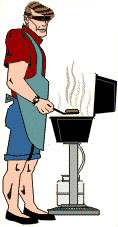|
Whatever
the reason, more than 75 percent of Americans own a grill and use
it about once a week, according to the Barbecue Industry
Association. People are firing up the grill every night of the
week ó thatís 2.3 billion barbecues a month.
People
have been cooking food over an open fire for more than 100,000
years, and the process is only gaining in popularity. The art of
cooking over fire, of course, was done by our ancestors out of
mere necessity.
There
are several theories of how it all began, but the word barbecue
comes from the Haitian word "barbacoa," which means a
framework of green sticks. Spaniards picked up both the word and
this method of cooking when they visited the Caribbean, and spread
both to Europe. There has also been speculation that the word
comes from the French "barbe a queue," roughly
translated "from head to tail."
One
of the first known grills was found around 5000 B.C. on the Greek
isle of Crete. Various grilled dishes, or yaki, have been enjoyed
in Japan for centuries ó long predating Emperor Hirohito's
reign, which began in 1926.

Whoever
discovered the method first may be up for debate, but the backyard
barbecue is now embedded forever as a part of true Americana,
right alongside apple pie and the flag.
Author
Steven Raichlen, who traveled 150,000 miles and visited 25
countries on five continents to do research for his book "The
Barbecue Bible," states a top 10 list of how to grill
properly:
1. Be
organized
Have
food, marinade, basting sauce, seasonings and equipment next to
the grill before you start.
2.
Check the fuel
Make
sure you have enough charcoal or gas. There should be enough lit
charcoal to form a bed of glowing coals three inches larger on all
sides than the surface holding the food. A gas grill tank should
be at least one-third full.
3.
Preheat the grill
To
achieve the desired seared crust of meat, charcoal flavor and
grill marks, the grill must reach 500 degrees. Let charcoal burn
until itís covered with a thin coat of gray ash. Hold your hand
six inches above the grate ó if you can keep your hand there
only three seconds before taking it away, the temperature is
right. A gas grill should be preheated to at least 500 degrees
also, which takes 10 to 15 minutes.

4.
Keep it clean
Clean
the grill twice: once after youíre preheated it and again when
youíre done cooking. Use the edge of a metal spatula to scrape
off food and a stiff wire brush to scrub the grate.
(To
top of second column in this article) |
5.
Oil the grate
Before
placing food on the grate, spray or brush it with cooking oil.
6.
Turn, donít stab
Use
tongs or a spatula to turn meat on the grill; donít stab it with
a carving fork, which drains the juices onto the coals.
7.
Know when to baste
Oil
and vinegar, citrus and yogurt-based bastes and marinades can be
brushed on meat while cooking, but never use marinate that raw
meat or seafood has been soaking in, during the last three minutes
of cooking. Apply sugar-based barbecue sauce toward the end of the
cooking time, since the sugar burns easily and shouldnít be
exposed to prolonged heat.
8.
Keep it covered
When
using the indirect method of grilling large items like a prime
rib, keep the grill tightly covered. Every time you lift the lid,
you add minutes to the cooking time.
9.
Give it a rest
Anything
will taste better after letting it stand for a few minutes before
serving, allowing the meatís juices to return to the surface.
10.
Never desert your post
Grilling
is easy but demands attention.

An
entire meal can be prepared and cooked on the grill ó from an
appetizer like french bread topped with roasted garlic and red
peppers to a dessert of grilled peaches, bananas and pineapple
topped with ice cream. Vegetables such as eggplant, asparagus,
baby carrots, leeks, sweet peppers, new potatoes, squash, zucchini
and even corn on the cob are all easy side dishes to prepare on
the grill and are also a healthy sidekick to steak or fish
prepared over an open fire. To speed up grilling time, partially
precook chicken, spare ribs, potatoes, carrots and other
slow-cooking food in the oven or microwave.
Although
there are some people who really donít enjoy eating outdoors,
are intimidated by the whole method of grilling, or simply think
itís too much trouble, they are a minority. Some local residents
say they grill almost every night. Even though summer and fall are
the most popular times to prepare food and eat outdoors, many
people just canít bear to put the grill away for the winter. And
although grilling has always been popular, people are expanding
their menu items and trying healthier choices, like fish and
seafood. They are also discovering that preparing something
besides hot dogs and hamburgers is easier than they thought.
[Penny
Zimmerman-Wills] (Note:
The second part of this article will be posted tomorrow.)
|



